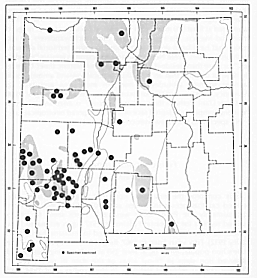

Geographic ranges vary tremendously. While Mountain Lions occur from southeastern Alaska to southern Argentina and Chile, some kinds of desert land snails occur only on single small desert mountains. On the other hand, there are only seven kinds of native cats in all of North America (and no more than two in any genus), while there are 25 species of the land snail genus Ashmunella recognized just in New Mexico alone.
These contrasting figures are not accidental, but tied in with the biology of the animals. The Mountain Lion is large and mobile—it may make a several hundred mile circuit in its hunt for sustenance. Movement between disjunct highlands is commonplace.
Snails, though, are small, and their slow pace is legendary. Most
individuals would die of old age long before making it from one mountain to a nearby
peak. Spreading out slowly during benign climates, snails became marooned in the more
hospitable highlands as conditions degenerated. Isolated, each population has evolved
without entanglements with others, eventually becoming separate species. Mountain
Lions, never isolated, remain one species.

Contributor: Arthur H. Harris, Laboratory for Environmental Biology, Centennial Museum, University of Texas at El Paso.
Desert Diary is a joint production of the Centennial Museum and KTEP National Public Radio at the University of Texas at El Paso.

An example of a range map. Each dot represents a record of Mountain Lion (Felis concolor) as of the mid 1970s. Shaded areas represent Ponderosa Pine forest and higher-elevation vegetation. Contour lines are for 5000 ft. After Findley, et al., 1975.
Findley, J. S., A. H. Harris, D. E. Wilson, and C. Jones. 1975. Mammals of New Mexico. University of New Mexico Press, Albuquerque, 360 pp.